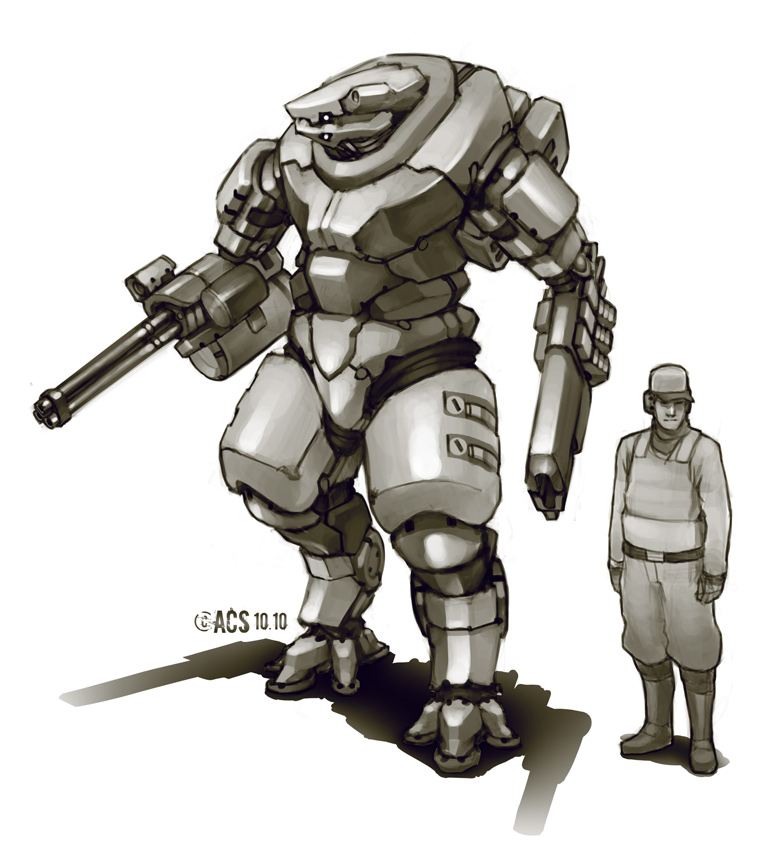Alndys
Mercenary, Artist.


Intent: The purpose of the Lapetus Armored Exoskeleton is to provide heavy armored support to infantry troops - not unlike a tank, though with less raw firepower. Focus is placed upon keeping the operator safe from the elements and most small weapons fire.
Development Thread:
Manufacturer: Byrec Lasood, Browncoat Arms | Cade Lee Designer
Model: Lapetus-Class
Affiliation: Byrec Lasood
Modularity: Yes, though it requires considerable time and specialized facilities.
Production: Currently Unique
Material: Durasteel Hull, treated to prevent corrosion during long use in heavy rain or moist atmospheres. A relatively thin ceramic layer runs over key instruments and subsystems, mainly for attenuative and insulation purposes.
Description: The 'Lepetus' Exoskeleton armor is, simply put, a durasteel armored suit designed to provide infantry support. Vaguely humanoid in form insofar as it has two arms, two legs, and a head, the Lepetus stands on two unguligrade, four-toed 'feet' designed specifically to support and disperse it's massive weight. The lower half of the Lapetus was inspired largely in part by large terrestrial birds, with 'backwards' legs that upgrade the suit's mobility from 'Abysmal' to 'not that great'. The legs have limited mobility, as the pilot's own legs are designed to rest inside the 'thighs'. At full speed, the Lapetuscan run at about 24Kph. When drawn up to full height, it is just over 3.5 meters tall.
The torso of the Lapetus is thick and bulky, as it is the main housing for the suit's primary computers, systems and auxiliary power pak. The auxiliary power pak is suitable for little more than basic sensors and opening the cockpit in case of the loss of the primary power source. This area is also the pilot's housing, with little room for anything else. On the back of the Lapetus, housed within a thick Durasteel shell is the primary power pak that provides the suit with mobility.
Compared to it's legs, the Lapetus' arms are relatively thin. Each ends with weapon, which can be changed out in a suitably outfitted facility. The Lapetus was designed primarily to carry twin chainguns, saturating an area with inaccurate supressive fire. When firing, the arms of the Lapetus lock into position, which reduces it's ability to follow a fast-moving target but also prevent a good deal of accuracy loss due to recoil - not unlike a Droideka. Changing the weapons on the Lapetus requires specialized equipment, and a fair amount of money. Thus, it is usually not worth the cost.
The sensors of the Lapetus are housed mainly in the head of the suit, providing the pilot with 75 degrees of vision. It has simple binocular vision enhancement, though it does not allow the pilot to see much farther than normal human vision would. The primary enhancement that the sensors provide outside of a human's normal capabilities is nightvision.
The thick hull of the armored suit is designed to deflect or absorb small weapons fire - typically, most blaster pistols and rifles carried by infantry. Larger weaponry, such as a mounted gun or large ballistic fire, will deal considerable damage to the suit. Turbolaser fire can shred the Lapetus with little effort.
The Lapetus carries no special protections from lightsabers, and consider it's limited view range and trouble tracking targets with high mobility, Force-users are a serious threat to the craft. Although bipedal, it typically fills the role of a mobile assault vehicle in ground combat.
The Lapetus is airtight, but has no capability to swim, float, or operate in space. A compact filtration system protects the pilot from most typical poison gasses, though particularly corrosive or virulent ones will reach them. Completely sealed and without the use of it's filtration system, the Lapetus has about a five hour air supply. If simply used for travel, the Lapetus' power pak can keep it moving for roughly two weeks before needing a charge. Using the dual chainguns drastically lowers this.
The basic design of the Lapetus - with forward-facing weaponry, it's vital power supply on it's back - means that the Lapetus is ill-suited to fleeing an engagement as it will expose it's weakest points in the process. Due to the difficulty it can have in tracking a mobile target combined with it's rear blind spot, the Lapetus is best served to have several infantrymen supporting it in combat.
Classification: Other
Weight: 4082 Kilograms
Quality: 9-10

